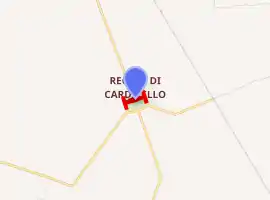Royal Palace of Carditello
This 18th-century palace located on the Royal Estate of Carditello (also known as the Reggia di Carditello) is a small palace once belonging to the Neapolitan Bourbon Monarchy and its surrounding grounds in San Tammaro, a small village in the province of Caserta in the region Campania. While the estate functioned as an agricultural and pastoral production center, and included large amounts of royal territory, the palace delighted members of the court as a hunting lodge. The palace was designed by Francesco Collecini (1723-1804), pupil of Vanvitelli. The forecourt had a large horse racing track. Many years of disuse and the last world war led to much degradation, specially of its frescoed interior. in January 2014, the palace was acquired by the Italian Ministry of Cultural Heritage.[1]
| Royal Palace of Carditello | |
|---|---|
Reale tenuta di Carditello | |
 The façade of the palace. | |

| |
| Alternative names | Reggia di Carditello |
| General information | |
| Type | Palace |
| Architectural style | Italian Baroque, Neo-Classical |
| Location | San Tammaro Caserta, Italy |
| Client | Charles III of Spain, Ferdinand I of the Two Sicilies |
| Technical details | |
| Floor count | 2 |
| Design and construction | |
| Architect | Francesco Collecini, Luigi Vanvitelli |
Invalid designation | |
| Official name | Reale tenuta di Carditello |
| Type | Non-movable |
| Criteria | Monument |
| State Party | Italy |
The palace
The palace was built in the second half of the 18th Century, by Charles of Borbone. The complex is 300 meters long and divided into 3 parts: on two sides we can find two factories that are divided by the main palace with two deep halls. There are 3 buildings that are linked between them because the Royals wanted to show that there weren’t barriers between the people and the Royal Family.
On the ground floor we can find kitchens, weapons stock, and the staff room. On the first floor there are two places: one for the Royal Family and on another one (saloon) for the reception that were organized after the hunting.
The small church is very interesting with typical 18th style, its decoration was made by the main artists of the court such as Philip Hackert.
The royal site enchanted Wolfgang Goethe who wrote that people need to go the royal palace of Carditello to understand what nature really was.
Carditello offered the King and his court particular hunting trips because the woods were rich in game.
Carditello is the only European royal palace that shows a view for horses embellished with fountains in the surrounding area finished after the unification of Italy. Unfortunately, Carditello knew a long period of disinterest.
In 1920, 2070 hectares of the mansion were sold. During World War II, it was occupied by German and American troops. That increased the state of degradation of the place.
References
- Gian Antonio Stella (9 January 2014). "La Reggia dei Borbone appartiene agli Italiani. La villa di Carditello ora è proprietà dello Stato". Corriere.it (in Italian). RCS Mediagroup S.p.a. Retrieved 9 January 2014.
.svg.png.webp)